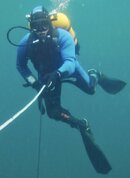There’s more than one way to configure sidemount. It’s not all using a single lower boltsnap and long neck bungee.How could doing it twice with the tank hanging loose be easier. Side mount is an absolute pain on land, and the only time its comfortably in the water is horizontal back up. A low ceiling is the only in water advantage of side mount over back mount . In water you’re constantly fiddling with your gear in side mount, loose tanks changing buoyancy as they empty, there’s nothing worse than something loose hanging off you when diving. I tried it for two years because I believed it would help with the weight of the twinset but it caused more hassle than it solved. The amount of hoses alone is a pain and they have to be an exact length. I sold the whole lot and went back to the simple, clean, back mounted twinset, a pleasure to dive in.
Carrying—portaging—kit is about splitting it into convenient packages to be carried to the site. Sometimes this may mean reconfiguring it en-route, for example if moving it through restrictions or lifting it past obstacles.
Twinsets and CCRs tend to be bulky and very fixed in the way they’re carried due to their weight. Sidemount, even using steel 12 litre cylinders, can be packed in protective rucksacks and carried individually.
It’s not all extreme expeditions. Just take an awkward path over a beach to dive alone. A twinset, for redundancy, is an absolute pig to handle. Setting it down the weight makes it nigh-on impossible to don and then stand up without severe difficulty. Sidemount would be three pieces; the harness with weights and two cylinders. Quite easy to carry, don and assemble whilst standing. Same with doffing the kit without busting a blood vessel.
All my sidemount cylinders use a top boltsnap which makes it easier to carry and keep in place without uncontrolled "drooping" as the bungee is stretched.





